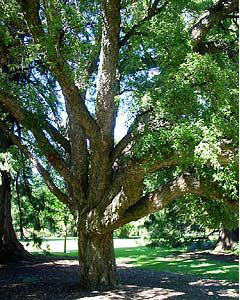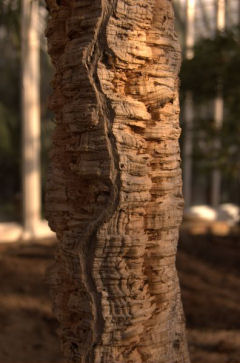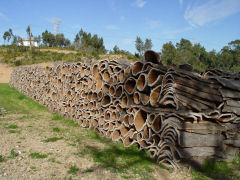All flooring materials in our homes have an environmental impact during manufacture, use and disposal. Wool and nylon use lots of chemicals and energy. Typically wood flooring involves the destruction of both the trees and their habitats for other creatures.
If you are concerned about the environment then you should consider cork flooring.
Environmental Impact
Forestry
Cork is harvested from the outer bark of the cork oak tree Quercus suber. After 10-12 years the bark re-grows, allowing the cork to be harvested again. This process can be repeated many times during the lifetime of the tree, making cork a renewable resource.
Carbon Sink
Harvesting the bark from a cork oak tree causes it to absorb 3 to 5 times more carbon dioxide than one that is not harvested. Over its lifetime it can absorb 700Kg of CO2.
Properties of Cork
Thermal
As illustrated in the table to the right, cork is one of the most insulating building materials.
Interaction with Water
Used down the ages as a bottle stop, cork is renowned for resistance to water.
5% of cork is composed of hydrophobic seroids and 45% suberin, which ensures its impermeability to water and humidity.
Mechanical
Cork is composed of tiny gas-filled cushion cells lined with flexible suberin. Millions of these cells together create a substance which is highly compressible yet resilient.
Acoustic
Cork's flexibility and cellular structure also gives it remarkable sound-absorbing properties.
Benefits of Cork Flooring
In addition to the environmental benefits of cork, here are a few great things about cork flooring:
Warmth & Insulation
Warmer than wool, cork flooring absorbs very little heat and feels warm to the touch. Lay over a concrete subfloor to insulate from the cold.
Water Resistant
Whilst not water-proof modern cork floorings have exceptional water resistance. Unlike carpets, spills can easily be mopped up.
Sound Insulating
Like soft furnishings and curtains, cork flooring helps to absorb sound from the air. In addition, it helps to reduce sound transmission along the floor and between floors.
Safety
The cushioning nature of cork flooring is safer for children and the infirm making it popular for nurseries and homes for the elderly.
Sources of Cork Flooring
Ireland: www.naturocorkflooring.ie
USA: www.ifloor.com
Canada: www.europlex.ca/eurocork.cfm
Wood Flooring
In addition to cork, its also worth considering Wood Flooring from sustainable source as an alternative. Some types of solid wood diy flooring are also very easy to install.
Certain species of wood such as acacia are farmed rather than taken from forests and re-planted.

| Material | Conductivity (W/mK) at 25°C | Resistivity (mK/W) at 25°C |
|---|---|---|
| Felt insulation | 0.04 | 25 |
| Fiberglass | 0.04 | 25 |
| Corkboard | 0.043 | 23.3 |
| Wool | 0.07 | 14.3 |
| Softwoods e.g. pine | 0.12 | 8.3 |
| Plywood | 0.13 | 7.7 |
| Plaster Board | 0.17 | 5.9 |
| Concrete, light | 0.42 | 2.4 |
| Glass | 1.05 | 0.95 |
| Limestone | 1.26 - 1.33 | 0.75 - 0.8 |
| Concrete, stone | 1.7 | 0.59 |
| Marble | 2.6 | 0.38 |
| Granite | 1.7 - 4.0 | 0.25 - 0.59 |
| Steel | 46 | 0.022 |
| Source: EngineeringToolbox | ||


All images courtesy of Wikipedia